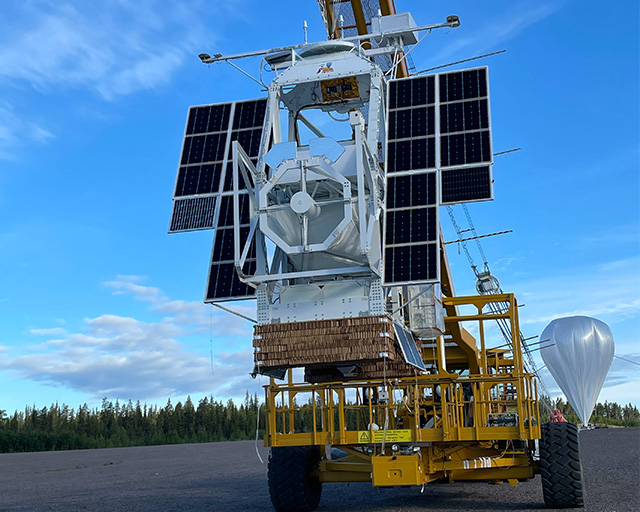A look behind the scenes – The Sunrise III project
The Sunrise III mission is an international research project with the aim of investigating the physical processes in the Sun’s atmosphere. At the Fraunhofer IST, special filters were coated which are essential components of the scientific instruments on board the balloon-borne observatory. These high-precision filters enable solar observations to be performed with previously unattainable accuracy, thereby contributing towards research into solar activity and its influence on space weather. We spoke to our colleague Stefan Bruns, who was involved in the work at the Fraunhofer IST.
Dear Stefan, what is the Sunrise III mission about? Who is involved in it?
In Sunrise III, research is being carried out on the solar atmosphere with regard to processes in the magnetic field and convective plasma flows. The project was led by the Max Planck Institute for Solar System Research (MPS) in Göttingen. Groups from the USA, Spain and Japan were also involved (https://www.mps.mpg.de/solar-physics/sunrise-team). As a result of the Earth’s atmosphere, the ultraviolet spectral range of sunlight is normally very strongly attenuated. The optical instruments for this mission were therefore suspended from a helium balloon, which ascended into the stratosphere and flew from Kiruna in Sweden all the way to northern Canada over a number of days.
What contribution towards the mission was made by the Fraunhofer IST?
We received a contract from the MPS for the coating of four different optical filters. Each filter was to transmit only a narrow band of scientifically interesting wavelengths. The aim was to detect different elements such as titanium, chromium, iron or magnesium and calcium, which are present at different altitudes in the solar atmosphere. In order for the measurement to work correctly and to ensure that the results are not overlaid by other information, the filters must completely block or reflect all other wavelengths of light.
What were the challenges during development and how did you overcome them?
As our filters are based on interference, i.e. the superimposition of light waves, we always need two materials: one with a high refractive index and one with a low refractive index. We had to develop new coating processes for the filters using the highly refractive material zirconium dioxide, whereby a particularly high level of purity is necessary for the source material, as impurities lead to undesirable absorption. Simultaneously, the coatings had to be particularly smooth in order to prevent further light losses due to scattered light, which occurs particularly strongly in the ultraviolet range. In this way, we were able to reduce the loss of light through the filters, which consist of up to 250 layers with a total thickness of 25 µm.
What significance does the project have for the Fraunhofer IST?
Through the project, we at the Fraunhofer IST were able to gain valuable experience and to expand our range of services in the field of precision optics. We now possess the necessary materials in the form of cylindrical targets, as well as processes for coating with zirconium dioxide. This material is significantly more cost-effective than hafnium dioxide, which is often used for similar applications. Furthermore, in this project we were able to extend the spectral range for optical coatings on the EOSS system to the ultraviolet range. At the same time, coating-thickness control was enhanced by means of transmission measurements during deposition for a high number of layers.
Have any initial results already been achieved, and if not, when will they be available?
Initial images are available, which were transmitted in low resolution during the flight. They show a clean signal with very little stray light, which indicates that all the optical components of the device were working excellently. Without the filters, too much stray light would have been recorded and the physical information on speeds, the strength and direction of the magnetic field, as well as temperatures, would exhibit a large error. The actual data analysis is, however, still ongoing. As more than 200 TB of raw data was generated, the first review of the material will take until late fall.
What happens next? Are follow-up projects planned? Do other applications exist for the filters?
We had already coated the filters for Sunrise III a few years ago, and now, after extensive testing, they are being utilized. The demand and application potential for optical filters of this type, known as bandpass filters, is huge: they are used frequently in analytics, whether on a satellite for earth observation or in a smartphone for gesture control. The spectral range and the utilized materials differ depending on the application. Furthermore, the requirements with regard to blocking or the rapid transition from high transmission to high reflectance continue to become more stringent. We take this into account in our developments: We have now produced filters with almost 600 layers and a total thickness of 40 µm – almost as thick as a human hair(!) – in order to fulfill such specifications.
A personal question to finish: What did you find so exciting about the project? / What did you find particularly fascinating about this project?
I really enjoy it when the results of my and our work are directly helpful for a specific application. Such flying projects generally involve a multitude of partners, which means that the components always have to comply with a particularly large number of requirements. It was exciting to be able to fulfill the requirements regarding the optical and mechanical properties and, at the same time, those regarding the required environmental resistance. And it is, of course, a very special achievement if I can contribute towards gaining an understanding our origins, our living conditions. After all, researching the Sun is about nothing less than that.
Last modified:

